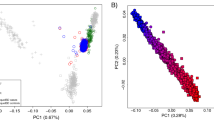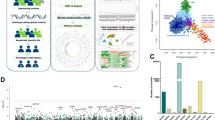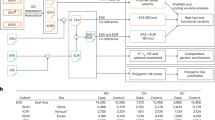Abstract
Evidence from four independent linkage studies and two meta-analyses of genome-wide data support the existence of a locus conferring susceptibility to inflammatory bowel diseases (IBD) in chromosomal region 19p. Identification of a susceptibility allele in this ∼28.5 Mb region with over 600 genes is a formidable task. To tackle this problem, we undertook two approaches: (1) haplotype-based candidate-gene screen, and (2) evaluation of previously reported associations. For the former, we selected genes with potential implication in IBD pathogenesis based on published functional and expression data, typed SNPs, constructed haplotypes, screened for association in 180 IBD trios, and followed up preliminary associations in 343 IBD patients and 207 control individuals. Overall, we analyzed 465 SNPs, and 260 haplotypes distributed across 56 candidate genes. We found suggestive evidence of association (nominal P<0.01) with four genes (C3, FCER2, IL12RB1, and CRLF1) in a screening stage, but were unable to confirm these preliminary observations at follow-up. In the second approach, we typed four nonsynonymous polymorphisms in genes C3 (R102G and L314P) and ICAM1 (G241R and K469E) in four independent cohorts totaling 2178 IBD cases. We evaluated these data together with previously published reports for three of these variants (C3-Gly102, ICAM1-Arg241, and ICAM1-Glu469), in a meta-analysis. Our pooled meta-analysis provides compelling evidence against association of these variants with disease. Overall, we performed the most comprehensive candidate-gene association study for IBD to date. The information hereby generated constitutes a valuable resource to investigate other common genetic immune diseases, such as celiac disease.
Similar content being viewed by others
Log in or create a free account to read this content
Gain free access to this article, as well as selected content from this journal and more on nature.com
or
References
Kornbluth A, Sachar DB, Salomon P : Crohn's disease; in Feldman M, Scharcchmidt BF, Sleisenger MH (eds): Sleisenger and Fordtrans's Gastrointestinal and Liver Disease. London: WB Saunders, (1998), vol 2, pp 1708–1734.
Jewell DP : Ulcerative colitis; in Feldman M, Scharcchmidt BF, Sleisenger MH (eds): Sleisenger and Fordtrans's Gastrointestinal and Liver Disease. London: WB Saunders, (1998), vol 2, pp 1735–1761.
Rioux JD, Silverberg MS, Daly MJ et al: Genomewide search in Canadian families with inflammatory bowel disease reveals two novel susceptibility loci. Am J Hum Genet 2000; 66: 1863–1870.
Cho JH, Nicolae DL, Gold LH et al: Identification of novel susceptibility loci for inflammatory bowel disease on chromosomes 1p, 3q, and 4q: evidence for epistasis between 1p and IBD1. Proc Natl Acad Sci USA 1998; 95: 7502–7507.
Ma Y, Ohmen JD, Li Z et al: A genome-wide search identifies potential new susceptibility loci for Crohn's disease. Inflamm Bowel Dis 1999; 5: 271–278.
van Heel DA, Fisher SA, Kirby A, Daly MJ, Rioux JD, Lewis CM : Inflammatory bowel disease susceptibility loci defined by genome scan meta-analysis of 1952 affected relative pairs. Hum Mol Genet 2004; 13: 763–770.
Williams CN, Kocher K, Lander ES, Daly MJ, Rioux JD : Using a genome-wide scan and meta-analysis to identify a novel IBD locus and confirm previously identified IBD loci. Inflamm Bowel Dis 2002; 8: 375–381.
Fox JG, Rogers AB, Whary MT et al: Gastroenteritis in NF-kappaB-deficient mice is produced with wild-type Camplyobacter jejuni but not with C. jejuni lacking cytolethal distending toxin despite persistent colonization with both strains. Infect Immun 2004; 72: 1116–1125.
Fiocchi C : Inflammatory bowel disease: etiology and pathogenesis. Gastroenterology 1998; 115: 182–205.
Blumberg RS, Saubermann LJ, Strober W : Animal models of mucosal inflammation and their relation to human inflammatory bowel disease. Curr Opin Immunol 1999; 11: 648–656.
Grimwood J, Gordon LA, Olsen A et al: The DNA sequence and biology of human chromosome 19. Nature 2004; 428: 529–535.
Gabriel SB, Schaffner SF, Nguyen H et al: The structure of haplotype blocks in the human genome. Science 2002; 296: 2225–2229.
Lennard-Jones JE : Classification of inflammatory bowel disease. Scand J Gastroenterol Suppl 1989; 170: 2–6; discussion 16–19.
Podolsky DK : Inflammatory bowel disease (1). N Engl J Med 1991; 325: 928–937.
Su AI, Cooke MP, Ching KA et al: Large-scale analysis of the human and mouse transcriptomes. Proc Natl Acad Sci USA 2002; 99: 4465–4470.
Hampe J, Cuthbert A, Croucher PJ et al: Association between insertion mutation in NOD2 gene and Crohn's disease in German and British populations. Lancet 2001; 357: 1925–1928.
Excoffier L, Slatkin M : Maximum-likelihood estimation of molecular haplotype frequencies in a diploid population. Mol Biol Evol 1995; 12: 921–927.
Qin ZS, Niu T, Liu JS : Partition–ligation–expectation–maximization algorithm for haplotype inference with single-nucleotide polymorphisms. Am J Hum Genet 2002; 71: 1242–1247.
Spielman RS, McGinnis RE, Ewens WJ : Transmission test for linkage disequilibrium: the insulin gene region and insulin-dependent diabetes mellitus (IDDM). Am J Hum Genet 1993; 52: 506–516.
Martin ER, Monks SA, Warren LL, Kaplan NL : A test for linkage and association in general pedigrees: the pedigree disequilibrium test. Am J Hum Genet 2000; 67: 146–154.
Van Heel DA, Dechairo BM, Dawson G et al: The IBD6 Crohn's disease locus demonstrates complex interactions with CARD15 and IBD5 disease-associated variants. Hum Mol Genet 2003; 12: 2569–2575.
Elmgreen J, Sorensen H, Berkowicz A : Polymorphism of complement C3 in chronic inflammatory bowel disease. Predominance of the C3F gene in Crohn's disease. Acta Med Scand 1984; 215: 375–378.
Yang H, Vora DK, Targan SR, Toyoda H, Beaudet AL, Rotter JI : Intercellular adhesion molecule 1 gene associations with immunologic subsets of inflammatory bowel disease. Gastroenterology 1995; 109: 440–448.
Braun C, Zahn R, Martin K, Albert E, Folwaczny C : Polymorphisms of the ICAM-1 gene are associated with inflammatory bowel disease, regardless of the p-ANCA status. Clin Immunol 2001; 101: 357–360.
Low JH, Williams FA, Yang X et al: Inflammatory bowel disease is linked to 19p13 and associated with ICAM-1. Inflamm Bowel Dis 2004; 10: 173–181.
Matsuzawa J, Sugimura K, Matsuda Y et al: Association between K469E allele of intercellular adhesion molecule 1 gene and inflammatory bowel disease in a Japanese population. Gut 2003; 52: 75–78.
Papa A, Pola R, Flex A et al: Prevalence of the K469E polymorphism of intercellular adhesion molecule 1 gene in Italian patients with inflammatory bowel disease. Dig Liver Dis 2004; 36: 528–532.
Morris JA, Gardner MJ : Calculating confidence intervals for relative risks (odds ratios) and standardised ratios and rates. Br Med J (Clin Res Ed) 1988; 296: 1313–1316.
Botto M, Fong KY, So AK, Koch C, Walport MJ : Molecular basis of polymorphisms of human complement component C3. J Exp Med 1990; 172: 1011–1017.
Hirschhorn JN, Daly MJ : Genome-wide association studies for common diseases and complex traits. Nat Rev Genet 2005; 6: 95–108.
Purcell S, Cherny SS, Sham PC : Genetic Power Calculator: design of linkage and association genetic mapping studies of complex traits. Bioinformatics 2003; 19: 149–150.
Altshuler D, Brooks LD, Chakravarti A, Collins FS, Daly MJ, Donnelly P : A haplotype map of the human genome. Nature 2005; 437: 1299–1320.
Johnson GC, Esposito L, Barratt BJ et al: Haplotype tagging for the identification of common disease genes. Nat Genet 2001; 29: 233–237.
de Bakker PI, Yelensky R, Pe’er I, Gabriel SB, Daly MJ, Altshuler D : Efficiency and power in genetic association studies. Nat Genet 2005; 37: 1217–1223.
Van Belzen MJ, Meijer JW, Sandkuijl LA et al: A major non-HLA locus in celiac disease maps to chromosome 19. Gastroenterology 2003; 125: 1032–1041.
Acknowledgements
We thank the IBD patients and their families for their collaboration. We also extend our thanks to Tanja Wesse (Christian-Albrechts-University, Kiel, Germany) for technical assistance, and members of the Inflammatory Disease Research Group (The Broad Institute, Cambridge, USA) for helpful discussions. This study was supported by a research fellowship from the Crohn's and Colitis Foundation of America to MKT, the German Federal Department of Research and Education through the German National Genome Research Network (NGFN2) and the German Research Council (research group polygenic diseases; DFGFOR423) to SS, the Italian Health Minister (RC0503GA22) to VA, and grants from the NIH/NIDDK and The Broad Foundation to JDR.
Author information
Authors and Affiliations
Corresponding author
Additional information
Supplementary Information accompanies the paper on European Journal of Human Genetics website (http://www.nature.com/ejhg)
Rights and permissions
About this article
Cite this article
Tello-Ruiz, M., Curley, C., DelMonte, T. et al. Haplotype-based association analysis of 56 functional candidate genes in the IBD6 locus on chromosome 19. Eur J Hum Genet 14, 780–790 (2006). https://doi.org/10.1038/sj.ejhg.5201612
Received:
Revised:
Accepted:
Published:
Issue date:
DOI: https://doi.org/10.1038/sj.ejhg.5201612
Keywords
This article is cited by
-
Exploring effective approaches for haplotype block phasing
BMC Bioinformatics (2019)
-
Polymorphisms in the ADRB2 gene and Graves disease: a case-control study and a meta-analysis of available evidence
BMC Medical Genetics (2009)
-
Polymorphisms in the interleukin 3 gene show strong association with susceptibility to Graves’ disease in Chinese population
Genes & Immunity (2009)
-
MAST3: a novel IBD risk factor that modulates TLR4 signaling
Genes & Immunity (2008)
-
Gene-centric association mapping of chromosome 3p implicates MST1 in IBD pathogenesis
Mucosal Immunology (2008)



